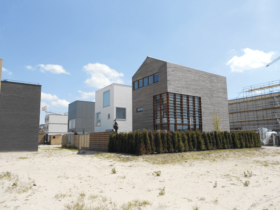
Use code BUILD for 20% off
Book here!
Use code BUILD for 20% off
Book here!One of the first questions people ask when considering renewables, from heat pumps to solar panels, is how long will it take to recoup the investment. The fuel source may be free, but installation is expensive, and many renewables use electricity to distribute the resultant heat. The trouble with the payback question is that it’s very hard to quantify, as it depends on so many things – the standard of insulation, services available and grants – but most heavily on the cost of energy and the price of the renewable technology.
The quickest win, with the fastest payback, is ensuring your home is well insulated in the first place: it makes sense to reduce the need for heat before specifying the technology to supply it. The Royal Institute of Chartered Surveyors (RICS) analysed the cost, annual savings, disruption and payback time of various energy-saving methods, and gave each a rating of one to five stars. Cavity wall insulation was awarded five stars: spending £440 would save £145 in fuel bills, paying for itself in three years, while an investment of £325 in extra loft insulation would save £60 annually, paying back in five years. The news is probably even better than that, since the figures were compiled before the 30 per cent hike in fuel prices in summer 2008, meaning insulating your home would save even more, and payback would be even quicker.
The only conceivable disadvantage to adding as much insulation as you can would be extra humidity and condensation, which could need mechanical ventilation. But even this can be turned to your advantage. Installing a heat-recovery ventilation unit, which transfers the heat from the extracted air into the fresh incoming air, can reduce the need for primary heat by up to 86 per cent. Manufacturers reckon that means a payback period of as short as five years on a unit costing £2,000, to £4,000 in a well-insulated house.
For maximum heat exchange, install the extract ducts from all the wet areas and high heat locations, such as kitchen, bathroom, wood-burning stove, etc. And to ensure even less heat loss, use a circulation-type cooker hood that is fitted with charcoal filters to recycle the heat from cooking.
As 75 per cent of the energy used in the home is for heating and hot water, for the quickest payback concentrate on those micro-renewable technologies that provide heat rather than electricity. To help the payback calculations, you first need to establish the cost of conventional fuels for comparison. These figures will vary from region to region, between tariffs, with different volumes, and different boiler efficiencies.
At the moment, the cheapest conventional fuel is mains gas, if you have it, since it comes out cheapest (see table below). But considering that gas has gone up 50 per cent in a year, and 90 per cent since 2003, it may well soon cease to be the most economic option. And as the price of fossil fuels will probably continue to rise faster than electricity – the main power source involved in renewables such as solar hot water and heat pumps – now’s the time to make the heating mechanisms in the house compatible with renewable technologies, such as installing underfloor heating, which in many cases works better with the lower flow temperatures of renewable heating systems. Producing 50 to 70 per cent of a building’s hot water requirements from renewable energy will provide a great buffer against future fossil fuel price increases.
So, as fossil fuel prices rise, how do the various micro-renewable methods stack up payback-wise? In general, solar thermal gives the shortest payback, at about 10 years, followed by biomass boilers, wind turbines and ground-source heat pumps, with solar photovoltaic (PV) having the longest payback, at about 30 years. These may seem like long periods of time, but they compare favourably with that staple of modern life – double glazing. High quality timber replacement windows for a whole house will have a payback period of 30 years.
It’s also important to remember that a renewable system will add value to the property as fuel prices go up, and energy efficiency becomes ever more valuable, thus improving payback figures even more.
Solar hot water heating is one of the cheapest technologies to install and has a shorter payback time than most other forms of alternative energy. A DTI investigation into systems installed between 1970 and 2000 found that a typical system provides 75 per cent of a household’s hot water measure over the course of the year (15 per cent in winter, and 100 per cent in summer), assuming a south-facing roof.
This will vary according to where you are in the country, with the south of the UK receiving more sunlight than Scotland. As a very rough guide, a 40-tube retrofitted system in London, eligible for the current low carbon buildings programme grant, has a payback of about eight years, although factors such as labour or repairs will add to this. Also note that if you’re retrofitting a solar thermal system to an existing house, they are not usually compatible with standard combi boilers, although condensing boilers are fine. This means you’ll have to invest in a standard boiler with a storage tank, which will add to the expense and delay the payback.
Heat pumps do not make heat, they just move it from one place to another. The higher the difference between the temperature of the source – ground, air or water – and the temperature you are trying to create, the harder the heat pump has to work and the lower the efficiency. This efficiency is often referred to as the coefficient of performance (COP), which translates as the number of kWh of heat produced for each kWh of electricity used. All heat pumps will have a COP of three or four under normal circumstances for flow temperatures of around 35°C, meaning they produce 3kWh of heat for each kWh of electricity, and they are cheaper to run than gas, assuming gas at current prices, and electricity at a standard rate. By using cheap-rate electricity to run the heat pump, and especially for its power-hungry start up, greater savings can be made.
According to Ice Energy, assuming a typical COP of 3.6, a heat pump would cost £250 a year less than gas, and £650 a year less than oil for domestic hot water. Once the temperature of the ground or air drops to a certain degree, the COP will fall to two or less. One way round this could be a ‘bivalent’ system, which involves a conventional gas-fired boiler taking over the heating load when the temperature outside drops too low.
With ground-source heat pumps, another factor to consider is the cost of installing the piping. It’s obviously far cheaper to install the necessary piping at the new-build stage, when diggers are in, than digging up the whole garden, and patio, later to retrofit the system. As a rule, the cheaper the installation, the quicker the payback.
Manufacturers of PV panels claim that a small home system can typically provide 25 per cent of all a home’s electricity needs, and in certain cases, they say, can provide a lot more, particularly if installed along with other energy saving technologies. Some properties, it is claimed, can generate 100 per cent of their energy needs. But PV panels get bad payback press.
The RICS estimates that since they cost up to £20,000 to install and last no longer than 30 years, they will never recoup the cost of their installation. However, Jeremy Leggett, executive chairman of Solar Century, countered that the RICS figures failed to take account of any rise in energy prices, when a conservative estimate of 10 per cent a year would have transformed the calculations. He also argued that the RICS didn’t take into account grants, the chance to sell electricity back to the grid and the increased value of an energy-efficient home. Taking all of the above into account, he put the payback of PV panels at 13 years. And, once again, if PVs are planned in as part of the building fabric, the more expensive the element they are replacing, the better the potential payback.
When it comes to using the force of the wind as a source of generating energy for your home, some companies selling domestic micro wind turbines suggest that payback is achievable in seven or eight years at current electricity prices, and this estimate does take into account grants and incentives. However, before you get too excited, get a wind survey done to see if it’s really a viable option. A windy area isn’t necessarily a good site if that wind isn’t constant and from one direction. Research by the Building Research Establishment in 2007 rather dispiritingly found that in many urban areas, micro turbines are unlikely to ever pay back their carbon emissions or the costs of installation and maintenance.
However, in windy locations, such as the outskirts of Wick and parts of Portsmouth (where the research was carried out) they can generate sufficient energy to pay back their carbon costs within months and then go on to make a positive contribution to combating global warming. But even when optimally sited outside major conurbations, financial payback is unlikely for all but the most efficient, low-maintenance and low-price turbines.
Bigger tends to be better, so it may be a good idea to get involved in a community project rather than installing your own equipment.
The opportunity to sell surplus electricity back to the grid is an issue that affects payback on all renewables, and one that was ignored by the RICS in its calculations. Sadly, the UK has a long way to go to catch up with other parts of the EU, where micro-generators are paid nearly twice as much per unit to export electricity to the grid than to import it, which potentially gives a greater chance of a payback and a far better incentive to install micro-generation.
While there are rumours of such generosity here, the UK system currently varies between suppliers and is complicated. There are two main options available. If you expect to generate a large surplus totalling more than 500kWh each year, you’ll need to get yourself an output meter approved by government regulator OFGEM, an export meter and a special inverter to synchronise your voltage with that of the national power grid. You will receive renewable obligation certificates (ROCs), vouchers worth about £50 per megawatt each. And your energy company will pay you for each kW you don’t need. EDF Energy and npower Juice’s green tariff could be just the thing for you.
If your generating kit is designed to supplement, rather than exceed, your energy use, you’d be better off with energy companies such as Ecotricity and Good Energy, which run schemes that give you a lower price per unit of electricity generated, whether you use it on site or export it. The amount for which you can sell each unit back to the grid depends on your electricity company.
Why is potential payback so often the main consideration when thinking of installing renewables? No-one questions the payback on a boiler, but unlike conventional fuels, renewables have the added value of reducing carbon emissions.
Coal, oil, electricity or gas suppliers don’t offer any payback at all, but you still have to service, maintain and renew conventional equipment. Self-builders, in their embracing of micro-renewables, are leading the way in looking beyond pure monetary issues.
Also remember:
Main image: This open-plan self-build home features solar thermal panels, a heat recovery system and woodburning stove


Comments are closed.